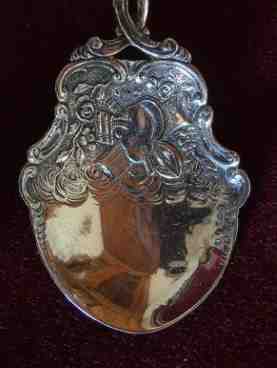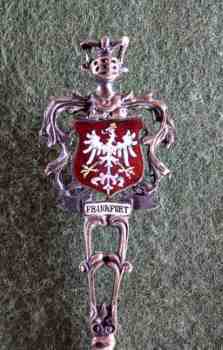
ASSOCIATION OF SMALL COLLECTORS OF ANTIQUE SILVER
ASCAS
| article # 200 |
|
|
|
|
(click on photos to enlarge image)THREE DECORATIVE SPOONSThe first illustration is of what is called a "berry spoon" although there was probably no such spoon ever produced so that the name is unlikely to be found in the pattern books of makers' workshops. This type of spoon was adapted from some other spoon and the type of decoration is almost exclusively confined to the Victorian period. The spoon shown here was a Hanoverian table spoon of circa 1757 assayed in London but the marks are so rubbed that attribution to its original maker is impossible and, of course, there is no way of knowing who was responsible for its subsequent decoration. This decoration includes the reshaping of the bowl to give it a somewhat shell-like appearance. The stem is heavily decorated with foliate engraving and this foliate concept has been carried into the bowl. The main decorative feature within the bowl is a group of three fruits which are embossed and then bright cut. These fruits are the standard form of decoration for these spoons consisting of a pineapple, a melon and a pear. The overall effect is quite striking and is sufficiently attractive that it does not much reduce the value of the piece as is the case with later decoration on other forms of plate, such spoons are usually sold to be used as "fruit spoons". The next illustration is, I believe, of Dutch origin although there is no original marking save for a small rectangular punch on the reverse of the bowl within which is the figure 030 (possibly). The front of the bowl is stamped with a London import mark for1930 and shows that the piece is of sterling standard. It is fairly certain that this 'spoon' was never intended to be used and would be quite inconvenient as a spoon. The bowl is engraved with motifs of musical inspiration with both instruments and sheet music which, like the fruits in the first illustration, have been raised by embossing. These motifs are displayed within a foliate surround. The finial is formed as a cargo ship which, notwithstanding that it appears to be carrying quite a large sheet of canvas which is itself decorated with an engraving of a stork or similar bird, is being loaded or victualled by a gang of men obliged to scale the side of the vessel by means of a ladder. The detail of the engraved work is quite exceptional and is apparent on the reverse as well as the front of the vessel. The stem of the spoon is definitely decorative rather than utilitarian and it, together with the finial, was probably cast and then soldered onto the bowl. The last illustration is of a spoon the decorative purpose of which can be in no doubt. The city arms forming the finial make it clear that this spoon was made in Frankfurt and the back of the bowl is stamped with the crown and crescent of the German Federal Act of 1884 which took effect in 1888. The fineness mark is 800 but there is no maker's mark. The whole is gilded. The outstanding feature of this spoon is its bowl within which is a miniature portrait of a gentleman in early 19th century dress who may be Goethe in later life. This portrait is of a very high quality indeed and there can be no doubt that the bowl of this spoon was never intended for any form of dining room use.
|







